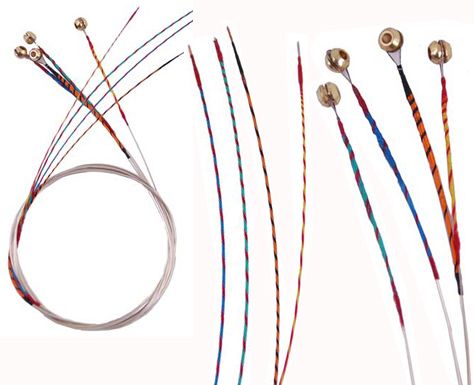Gut strings for instruments (Violins)
One of the most common things that people think about when the hear of the violin, is the idea that the strings of the instruments are made of gut. However, this is not usually the case anymore. In the Early Music world, we still use gut strings that have been recreated using similar techniques that have historically existed to produce them.
It wasn't until relatively recently (recently, for classical musicians) that the complete set of 4 strings were completely replaced by metal. In the 1920's it was still possible to find world-class soloists using even gut on the thinnest E string. In America, the trend was to take to the newer fad of the metal strings, partly due to the fact that it was more difficult to obtain high quality gut for the production of the strings. However, in Europe, it was not uncommon for orchestras to require that players stick only to gut strings.
Are they really cats guts?
Actually, no. Generally, they were made from sheep or cow (sometimes goat) guts. They were dried whilstbeing stretched and twisted under tension. In many ways, they were produced in a similar way to ropes. Afterwards, they were polished to ensure a smooth surface. Sometimes, to help resist humidity they were soaked in oil or "varnished". Other times, they had a thin metal wire twisted with the gut. This would increase the line density of the strings, thus making them thinner.
Differences to modern metal strings
Metal strings had the advantage of being more brilliant and powerful, characteristics that were useful in the expanding sizes of the concert halls. In addition, they were much more durable and less prone to destabilisation (from changes in heat and humidity) than their gut counterparts.
However, gut strings have a different warmer colour to their sound. They are appropriate for the balance of the music that they were written for. Thus, it is the belief of the Early Music community that the appropriate strings to use are those that were used with the instruments and music of the time.
Perhaps, if Bach had lived in our time he would have written music that was more appropriate for the tools we have now and would have taken advantage of the alternative sounds that were possible.
Running an ensemble is a rewarding but time consuming job. Chasing after grants and sponsorship is the often overlooked but important aspect of a musician's life. If our post has passed the reward period, please consider a donation or a delegation. We also accept tokens of support at the following addresses:
BTC
1Mwe6XaDcREa7o5RSLGoWfk9wSwGs6LkSA
LTC
LPcEtTsxMJykDeK713jsj3e2BsdVf32ix7
ETH
0x1bb1d830f66bdb74de45685a851c42b790587a52
Doge
DMJNS7jbNCgPdFdxgeFdEummFMmSQvAoK2
Musicoin
0x9c1fc741f0869115f8c683dc6967131ab1c40ebc
Thanks for you support!

The classical music community at #classical-music and Discord.
Follow our community accounts @classical-music and @classical-radio.
Follow our curation trail (classical-radio) at SteemAuto
Community Logo by ivan.atman




I had no clue they used to be made from guts... Really? Damn
Nope, just made it all up!
Yes, the technology for making thin wires and strings that were flexible was not very advanced during those times.
Thank you for an interesting post.
It was surprising to me when I started to realize how much overlap there is between musical performance and technology advancement. @cmp2020 and I went to a baroque ensemble's performance last year where the conductor pointed out that the piano didn't become widely available until near the end of Bach's career, and more recently we watched a Mozart documentary where the narrator talked about how Mozart was one of the first to really exploit the technical advancement that the piano gave to play notes with dynamics on a keyboard instrument. In modern times, the advance of technology for recording and production technologies, and now block chain seem new, and it probably moves faster, but I guess it's really just a continuation of a centuries old trend. The change from gut to metal for stringed instruments is another interesting example that I hadn't been aware of.
Yes, and the piano (fortepiano) was a completely different thing to the modern pianos of today. Different texture of sound, much smaller and different mechanics.
If you talk to a harpsichord, they would dispute the dynamics part! But yes, it was possible to make a different range of dynamics with the fortepiano.
Yes, it is interesting that many things mirror the advance of science and technology. After all, most people want to harness the advantages of the latest and greatest!
Something I always wanted to know but was afraid to ask 😉
Ha ha, never be afraid to ask!